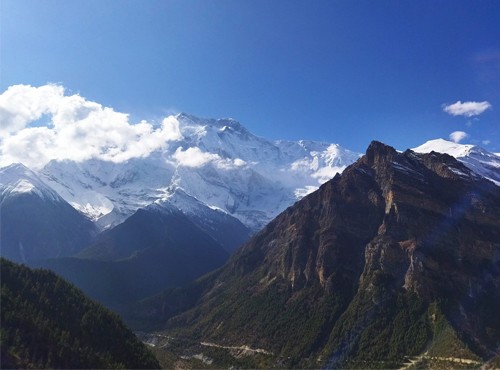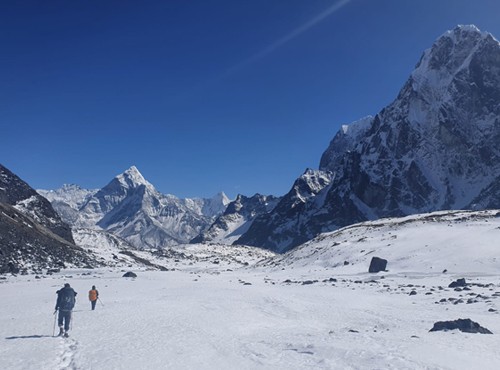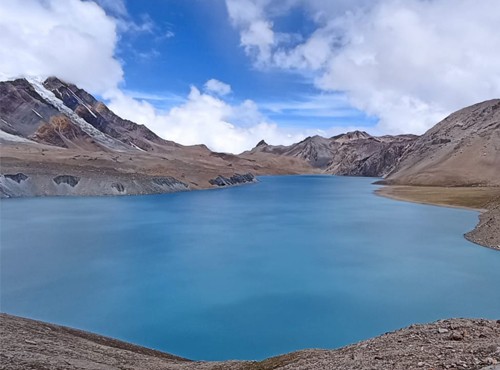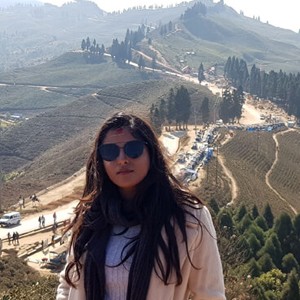Away from the famous trekking routes in Nepal, the Kanchenjunga region offers pristine and raw adventure in the Himalayas. Kanchenjunga trek either means you will be doing the Kanchenjunga Circuit trek, Kanchenjunga South Base Camp trek, or Kanchenjunga North Base Camp trek. The circuit trek includes both south and north base camps. We, Nepal Nirvana Trails, also have a Lumba Sumba Pass trek in this region that does not go to either base camp.
Unveiling the Hidden Gems of Kanchenjunga: Trekking Guide for Adventure Enthusiasts
Table of Contents
Trekking in the Kanchenjunga region is not easy. You will be exploring less trekked routes with deep valleys and remote villages. Even though there are tea houses available along the trails, the tourist infrastructure is still very bare minimum. Reaching the starting point of the trail from Kathmandu itself takes two days and includes long driving. So, to not only do but truly enjoy the Kanchenjunga trek, you have to understand everything about the region.
And this blog is all about that. We will provide all the information you need to know before embarking on any trek in the Kanchenjunga region. But first, let's talk about whether you should trek in the Kanchenjunga region solo or join a guided trip.
Trek Solo or Join a Guided Trip to Kanchenjunga?
Unlike the famous trekking routes in Nepal, for instance, Everest Base Camp, Annapurna Base Camp, or Annapurna Circuit, the Kanchenjunga trek route is inside a restricted area in Nepal. Therefore, foreign travelers cannot trek here solo, not even with an independent guide.
To trek in the Kanchenjunga region, you have to join a local registered trekking company like us, and we will organize the trip. Moreover, you also have to do this trek in a group of at least two trekkers, so if you are a solo traveler, you have two choices.
First, you can join our fixed departure Kanchenjunga trek in 2024/2025, or second, you can opt for a private trek, and we will do our best to find a partner for you for the journey. In a group trek, there would be 6 to 8 other trekkers, but in a private trek, there would be one or two other trekkers with you.
We will provide guides and porters as per the group size. Now, as it is clear that you will be doing the Kanchenjunga trek in a group, our blog will follow this factor.
Getting to Kanchenjunga
Arriving in Nepal
Our team will be at the Tribhuvan International Airport on your arrival day to pick you up and escort you to the hotel. You do not have to face the hassle of finding a taxi that will most probably charge you lots of money. Likewise, our team will also help you with the luggage and in the hotel.
Make sure you are all ready with the necessary documents needed to get an on-arrival visa if you have not obtained it from the Nepalese Embassy or Consulate Office in your country. In case you see any delays in your flight, inform us so that we can come to the airport at the right time to receive you.
Domestic Travel to the Kanchenjunga Region
The Kanchenjunga trail starts from Taplejung. The closest airport from here is Suketar, but as it is at a high altitude and sees quite an unpredictable weather pattern, the flight is often delayed or canceled. So, the other better alternative is flying from Kathmandu to Bhadrapur and driving from here to Taplejung. It takes 8 to 9 hours to drive to Taplejung from Bhadrapur. Likewise, you can also drive from Kathmandu to Taplejung in a local bus or private jeep.
Select the Right Kanchenjunga Trekking Route
We have four trekking packages in the Kanchenjunga region- Kanchenjunga Circuit trek, Kanchenjunga South Base Camp trek, Kanchenjunga North Base Camp trek, and Lumba Sumba Pass trek. All these four Kanchenjunga trek itineraries are different from each other, and you can pick any one you wish.
Below, we have briefly mentioned the major highlights of these packages that differentiate them. It will help you pick one:
Kanchenjunga Circuit trek
- It's an 18-day trek and starts at USD 1,900 per person (for solo trekkers).
- Explores both the south and north base camps of Mount Kanchenjunga.
- Crosses the Sele La pass.
- The journey starts with a morning flight from Kathmandu to Bhadrapur and the drive to Taplejung. From Taplejung, the trail begins.
- The Kanchenjunga circuit trek route: Sekathum-Amjilosa-Gyabla-Ghunsa-Khambachen-Lhonak-Kanchenjunga North Base Camp-Ghunsa-Sele La Base Camp-Sele La Pass-Tseram-Ramche-Oktang-Tortong-Yamphudin-Khebang-Kanyam-Bhadrapur-Kathmandu.
Kanchenjunga South Base Camp trek
- It is a 14-day trek program and starts at USD 1,900 per person (for solo trekkers). The group trekking price goes down to USD 1,399 per person as per the group size.
- Trek to the Kanchenjunga South Base Camp.
- The journey starts with a flight from Kathmandu to Bhadrapur, and from here, you will drive to Khebang. Khebang is the trailhead.
- Kanchenjunga South Base Camp trek route: Khebang-Yamphudin-Tortong-Tserma-Ramche-Yalung Glacier-Kanchenjunga South Base
- Camp-Tortong-Yamphudin-Khebang-Kanyam-Bhadrapur-Kathmandu.
Kanchenjunga North Base Camp trek
- It is a 16-day trek program and starts at USD 1,600 per person (in a group of two trekkers). The group trekking price goes down to USD 1,400 per person as per the group size.
- Trek to the Kanchenjunga North Base Camp (Pang Pema).
- The journey starts with a flight from Kathmandu to Bhadrapur and a drive to Taplejung. Taplejung is the trailhead.
- Kanchenjunga North Base Camp trek route: Taplejung-Sekathum-Amjilosa-Gyabla-Ghunsa-Khambachen-Lhonak-Kanchenjunga North Base Camp-Ghunsa-Sekathum-Kanyam-Bhadrapur-Kathmandu.
Lumba Sumba Pass trek
- It is a 21-day trekking program and starts at USD 6,600 per person (for solo trekkers). The group trekking price goes down to USD 3,600 per person as per the group size.
- This is the original trail to Everest used by early mountaineers in the early 20th century.
- Cross a high mountain pass called Lumba Sumba.
- The journey starts with a morning flight from Kathmandu to Bhadrapur and a drive to Ilam. From Ilam, you will drive to Sekathum. The trailhead begins from here.
- The Lumba Sumba pass trek route: Sekathum-II Danda-Selep Kharka-Olangchung Gola-Upper Langmale-Pass Camp-Chauri Kharka-Thudam-Yak Kharka-Chyamtang-Hatiya-Gola-Hedangna Gadi-Num-Tumlingtar-kathmandu.
Kanchenjunga Trek Difficulty and Duration
Trekking in the Kanchenjunga region takes at least two weeks. Our longest trek package in the Kanchenjunga region is 21 days long. You will be spending a long time in the mountains strolling from one village to another. The Kanchenjunga terrain is steep and rugged.
Untouched by the tourism development, there is nothing much along the trail apart from scattered tea houses. You have to be mentally prepared to be in the mountains and adjust to all the limited facilities. The trails are strenuous.
Frequent ascents and descents via rugged and steep tracks put lots of strain on the body. You will navigate through landslide-prone areas, moraines, and glaciers. Only trekkers with previous trekking experience and strong fitness are allowed to trek in the Kanchenjunga region.
The daily trekking hours are 6 on average, and some days involve 8 to 9 hours of walking as well. You have to be extra careful while trekking to avoid injuries. Likewise, there is also the risk of altitude sickness on this trek because of high elevations.
Overall, the Kanchenjunga trek is strenuous. It is known as the off-the-beaten trekking region in Nepal. The high altitude, unforeseen weather patterns, air pressure, and remoteness of the region make any trek in Kanchenjunga quite demanding.
How to prepare for trekking in the Kanchenjunga region?
To trek in the Kanchenjunga region, you have to be strong physically and mentally. The trekking routes in the Kanchenjunga region test your endurance and push you out of your adventure comforts. Do understand that the Kanchenjunga region offers a very raw and authentic mountain experience with minimum tourist infrastructure. So, your physical and mental fitness matters a lot.
To prepare for the trek, book your trip early and have 2 to 4 months on your hand. In this period, you will walk and exercise regularly. Likewise, research the trekking route you will be following and its limitations. Understand the region, locals, and their emotional sentiments. Nepal Nirvana Trail's team will help you in every step, from preparation to journey, to make the trek hassle-free for you.
To have a good level of fitness for the Kanchenjunga trek, you have to train your body. To do so, you can hike, run, swim, or cycle. These activities will help you build stamina and endurance. Likewise, if the gym is accessible to you, strengthen your core body and leg muscles. Regular long walks are also curricula to make the habit. We also recommend walking with a backpack weighing up to 5 kg.
You do not have to undergo any tough fitness training for this trek, however, you have to be serious and active. Also, practice mindfulness and composure. This will help you stay focused and adjust to the remoteness of the region. Pack smartly and get your trekking boots early. You have to get used to your trekking boots before the trek starts to avoid any blisters during trekking.
Things to do during the Kanchenjunga trek for a safe journey
Below are the things you should do during Kanchenjunga trekking for a safe journey:
- Listen to your body and maintain your pace. Do not rush. If you feel any discomfort, share with your guide.
- Be aware of altitude sickness symptoms and take necessary action in the presence of your team leader. These are the early symptoms of altitude sickness- vomiting, difficulty in breathing and sleeping, loss of appetite, nausea, dizziness, etc.
- Keep yourself hydrated. Drink at least 2 liters of water daily. Avoid drinking alcohol or smoking during trekking.
- Meet your doctor before the trek starts and get advice from him about altitude. If you are on any medication or have a health history that may get affected because of the nature of the Kanchenjunga trail environment, let your travel agent know.
- Be careful while trekking. Descending puts as much pressure as ascending, so do not be carefree and put your every step wisely.
Kanchenjunga Permits
To do Kanchenjunga circuit trekking, you will need a Kanchenjunga Conservation Area Project Entry Permit (KCAP) and a restricted area entry permit for the trail in Tapethok and Yamphuding VDCs. Our package cost includes these two permits, and the team will help you obtain them. Below is the permit cost:
- Kanchenjunga Conservation Area Project Entry Permit (KCAP): Nrs 2,000 per person
- Kanchenjunga Restricted Area Permit (RAP): USD 10 per person, per week
Best Time to Trek in Kanchenjunga
The Kanchenjunga trekking route sees a huge diversity in the vegetation, climate, and weather from the start to the end of the trek. The vast altitude range features a subtropical climate with higher temperatures in the lower part of the trail. The higher altitudes have an alpine climate with much colder conditions.
As you ascend, you'll notice a shift from lush forests and verdant valleys to rocky gorges and snow-covered mountains. To select the best time to do the Kanchenjunga trek in 2023/2024, you have to be aware of all four seasons and their pros and cons.
The Kanchenjunga region experiences diverse weather patterns throughout the year, primarily influenced by its altitude and the monsoon cycle. Below is the breakdown of all seasons:
- Spring (March, April, May): Spring is one of the best times for trekking in the Kanchenjunga region. The weather is relatively stable, with clear skies and moderate temperatures. This season is an ideal time for trekking if you wish to witness blooming rhododendrons and enjoy pleasant weather. There will be fewer weather-related issues during spring.
- Summer/Monsoon (June, July, August): The monsoon season arrives in full force during the summer months. Heavy rainfall is common, making trekking conditions challenging. Landslides and leeches are prevalent during this period. Trekking is not recommended in the monsoon season due to the risk and discomfort it presents. However, on the good side, the vegetation thrives.
- Autumn (September, October, November): Autumn is the most popular trekking season in the Kanchenjunga region. The weather is stable, and the skies are clear, providing excellent visibility of the mountains. The temperature is mild, making it a comfortable time for trekking. This season attracts the highest number of trekkers and mountaineers. The days are pleasantly warm, while nights can be cool at higher elevations.
- Winter (December, January, February): Winter in the Kanchenjunga region is cold, and higher altitudes experience heavy snowfall. Trekking is possible at lower elevations during the winter months, but high passes may be blocked due to snow and extreme cold. Suitable for those who can endure cold conditions and seek quieter trails.
Essential Packing List
Kanchenjunga trail presents a wide range of climates and temperatures throughout the trek because of the altitude variation. You have to be prepared for all possible weather conditions. Below is the packing list that will make sure you are prepared for all kinds of weather:
- Essentials: Daypack and rain cover, Duffle bag (provided by the company), Backpack and rain cover, Water bottle, Water filter, Stuff sack, Sleeping bag & liner, Trekking poles, Raincoat, Rain pants, Clothing (4-5 pairs of each item), Dry tees, Underwear, Trekking shirt and pants, Cotton socks, Woolen socks, Hiking shoes or boots, Down jacket, Fleece jacket, Windbreaker, Thermal wear, Sun cap, Scarf, Gloves, Woolen cap, hat
- Personalkit: Sanitiser, Toothbrush & paste, Hand wash, Wet wipes, Sunscreen, Lip balm, Cold cream, Face cream, Toilet paper, Soap, Shampoo, Comb, Sunglasses
- Personal Medical kit: Band-aid, Cotton, ORS or electoral powder, Antifungal cream, Insect repellent, Antiseptic cream, Bandage and spray for sprained joint, Paracetamol, Vomistop, necessary medications
- Electronic Gadget: Power Bank, Charger, Spare batteries, Camera, Headlamp/LED torch
- Documents: Identity card, Insurance, Permits, Passport, Visa, Photo
Tips for renting or buying gear in Nepal for the Kanchenjunga trek
You have the option to buy or rent trekking clothes and gear for the Kanchenjunga trek. If you are planning to go on frequent trekking expeditions, it is best to invest in your equipment, as they will be useful in future treks.
However, if you are looking for a budget-friendly option and you are not going to do frequent treks, you can rent the major and expensive trekking clothes and gear in Thamel, Kathmandu. Below, we have given some tips that will help you get a better deal on gear whether you rent or buy:
- Seek recommendations from other trekkers or your trekking agency to rent from a reliable place and ensure the quality and safety of the equipment.
- Before finalizing your rental, carefully inspect all the gear. Pay close attention to zippers, seams, and any potential weak points.
- Bargaining is common in Nepal. Don't hesitate to negotiate the rental prices, especially if you're renting multiple items or for a long period.
- Inquire if the rental shop offers insurance against equipment damage or loss.
- If you plan to buy gear, invest in high-quality equipment. Well-made gear will provide better comfort and safety during your trek.
- You will often find better deals and a broader selection in Thamel, Kathmandu.
- You can also consider buying second-hand trekking gear.
Tea house accommodation and the welcoming locals
Along the Kanchenjunga trek route, you will walk past numerous remote villages where you will stop for night stays. The primary accommodation on this trek is tea houses. Tea houses are a simple type of accommodation run by local families. The services in tea houses are very basic and require additional money for any extra facility like WiFi, charging, hot showers, etc.
The rooms are usually twin-shared with a common washroom. Single rooms are available in selected villages. Likewise, all the meals on this trek are served as per the menu of the tea house, which mostly includes dal bhat, thukpa, momo, pasta, noodles, sandwiches, curries, roti, soups, porridge, toast, eggs, oats, etc.
Kanchenjunga region is home to the kind Rai and Limbu communities. They go back to Tibetan origin and hold a unique belief system based on an amalgamation of Buddhist, Hindu, and animist principles. The trek lets you see their lifestyle in the remote Himalayas and learn about their culture, traditions, and practices. Likewise, you will also visit ancient monasteries like Ramtang and Oktang.
Get to Know the Locals of Kanchenjunga Region and Their Cultural Heritage
Kanchenjunga trekking offers a harmonious blend of off-the-beaten-path adventure and immersive cultural exploration within the remote Himalayan region of Nepal. Along the trek route, you will meet with diverse ethnic groups, including Rais, Sherpas, Limbus, Bhotias, Lepchas, etc.
As you traverse the winding trails, you'll have the opportunity to interact with these kind and welcoming people. Most of the locals here practice Buddhism. The trekking route has many stupas, chortens, prayer wheels, and monasteries.
The culture and lifestyle of the people in this region predominantly mirror Tibetan traditions. Their architecture, clothing, and even culinary practices have Tibetan influence. Locals highly rely on farming. In Ghunsa, you will see beautiful terraced fields of potatoes, barley, buckwheat, wheat, etc.
Facilities along the Kanchenjunga trail
Here's what you can expect regarding charging, WiFi, hot showers, baggage limits, and personal expenses along the Kanchenjunga trail:
- Charging: Charging electronic devices can be a challenge in remote areas. While some teahouses and lodges may offer charging facilities, they might be limited, and you may have to pay for the service. Get a power bank and solar charger for the trek.
- WiFi: Expect minimal or no WiFi connectivity during your Kanchenjunga trek. Embrace this opportunity to disconnect from the digital world and immerse yourself in the natural beauty and cultural experiences.
- Hot Showers: Hot showers are a luxury along the Kanchenjunga trek route. Most teahouses provide basic shower facilities, which are often heated by solar power or wood stoves. Be prepared for paid hot showers, or you can opt for a refreshing cold shower in the pristine mountain streams.
- Duffel Bag and Backpack Limit: Trekkers typically have a weight limit for their duffel bags, which are carried by porters. This limit is usually around 10 kilograms per trekker. Your daypack, which you carry, should be packed with essential items like water, snacks, extra clothing layers, and personal necessities.
- Tips: It is customary to tip your guides, porters, and teahouse staff for their hard work and hospitality. Your trekking agency or guide can offer guidance on appropriate tipping amounts.
- Personal Expenses: While the cost of the trek often covers accommodation and meals, you should budget for personal expenses such as snacks, additional meals, charging fees, hot showers, and any souvenirs you might want to purchase from local villages. Having some extra cash on hand is recommended.
Safety and Health Considerations
During your Kanchenjunga trek, you have to be prepared for the unique challenges that come with a remote, off-the-beaten-path adventure. We, Nepal Nirvana Trails, make sure you are trekking safely and enjoying the journey, but you also have to be cautious. Below are some crucial safety and health tips to keep in mind during this trek:
- Educate yourself about the symptoms of altitude sickness (AMS).
- Consume a balanced diet with an emphasis on carbohydrates for energy. Incorporate local foods and avoid heavy, difficult-to-digest meals.
- Carry energy snacks and stay well-fueled throughout the trek.
- Always use water purification tablets or a water filter to avoid indigestion. Do not drink untreated water from streams or taps.
- Maintain good personal hygiene to minimize the risk of infections. Use hand sanitizer and carry wet wipes for cleaning.
- Dress in layers and carry waterproof gear to protect against rain, snow, and cold temperatures.
- The higher altitudes expose you to increased UV radiation. Use sunscreen, sunglasses, and a wide-brimmed hat to protect yourself from sunburn.
- Use trekking poles for balance and support, especially on steep ascents and descents.
- Make sure you have comprehensive travel insurance that covers air evacuation and medical emergencies.
Eco-Trekking and Responsible Tourism
Kanchenjunga region has a very fragile ecosystem. Traveling sustainably is quite important for a better future. Here's how you can practice responsible tourism and contribute to the preservation of this beautiful area:
- Familiarize yourself with local customs and traditions. Ask for permission before taking photos, especially of people, villages, or sacred sites. Dress modestly and be mindful of local beliefs.
- Pack out all your trash and litter. Use provided waste disposal facilities and separate recyclables when possible.
- Minimize the use of single-use plastics and bring reusable containers for food and beverages.
- Instead of buying bottled water, use water purification methods like water filters or purification tablets.
- Stick to established trekking paths and avoid creating new trails. This helps protect fragile ecosystems and prevents soil erosion.
- Do not make campfires in the region, as wood is scarce and crucial for local communities.
- Do not disturb or feed wildlife.
- Keep noise levels down during your trek.
- Purchase local handicrafts and products as souvenirs, as this supports the local economy.
- If you are inspired by the community's efforts or are moved to contribute, consider donating or inquire about volunteer opportunities.
Conclusion
In conclusion, the Kanchenjunga trek is an adventure of a lifetime, offering the opportunity to explore the breathtaking landscapes and rich cultures of a remote Himalayan region. However, before you set out on this incredible journey, it's essential to be well-prepared.
From selecting your trekking time wisely to understanding the limitations of the region, you have to be smart for a safe and enjoyable experience. Be sure to research and select the time that aligns with your trekking goals. Likewise, book your Kanchenjunga trek with a reputable trekking agency like us Nepal Nirvana Trails.
Our two decades of expertise in the field ensure you receive top-notch guidance and support throughout your journey. With no hidden charges, transparent pricing, and 24/7 assistance, we are dedicated to making your trek as smooth and memorable as possible.
The Kanchenjunga region is a treasure in Nepal, and by trekking sensibly, you can make your adventure not only unforgettable but also sustainable for the generations to come!






